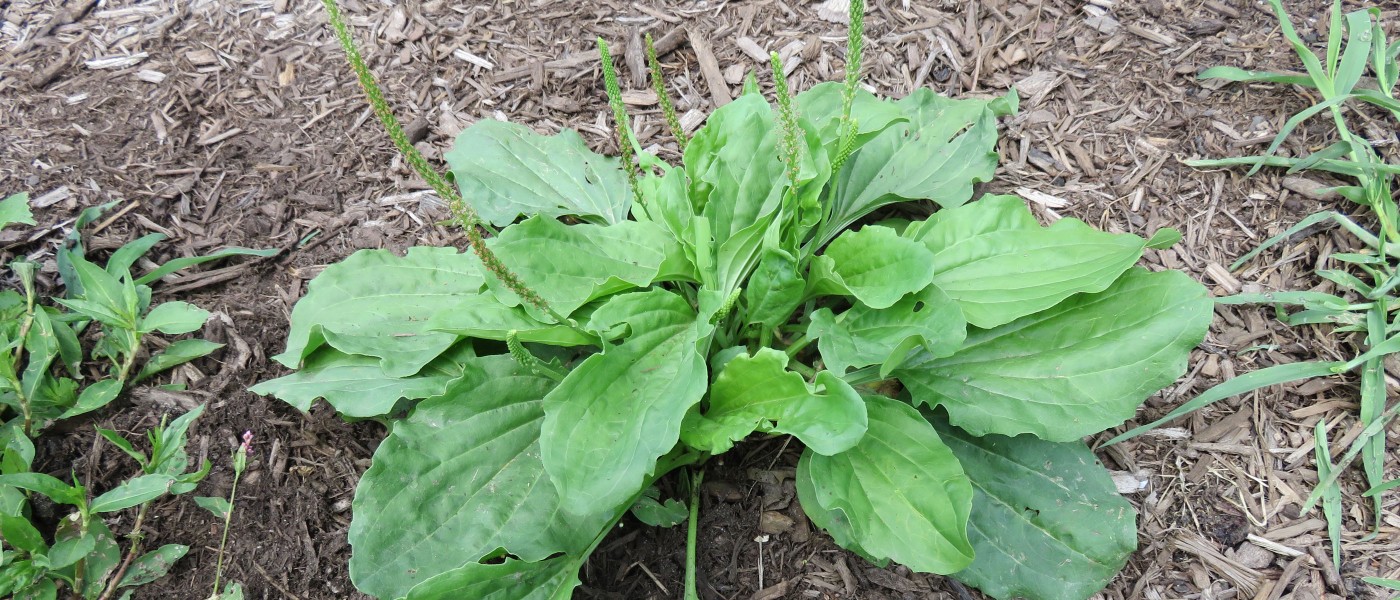Weed of the Month: Broadleaf Plantain
A regular in lawns and along paths, broadleaf plantain (Plantago major) is a weed you’ll see plenty of now and for the rest of the summer. Even among weeds, it’s incredibly persistent. Mow it, step on it, weed-whack it, and this tough perennial will return, thanks to its low-growing habit and regenerative crown. Luckily, it can also be put to good use—its leaves have anti-itch properties and can sooth bug bites (see recipe below).
The wide, glossy leaves of the broadleaf plantain are actually rather attractive. They have nearly parallel venation and grow in a rosette (circular arrangement). Since it is wind pollinated, the plant has no need for showy or colorful flowers. Instead it sends up green flower spikes that produce a profusion of seeds through the summer. These seeds are famously resilient and can remain viable in the soil for ages—by some counts up to 20 years! If you see a lot of broadleaf plantain, you know the surrounding soil is likely very damp and compacted. Over time, though, its fibrous roots break up hard soils, giving other plants the chance to grow there too.
Broadleaf plantain is unrelated to the plant that produces banana-like fruit. Its genus name, Plantago, comes from the Latin for “sole of the foot.” That’s most likely a reference to the shape of the leaf, but it’s an apt name for a plant that’s so common along footpaths, the more stepped on the better. It also has a history of being carried on foot throughout Europe and North America. In more recent years, its seeds were unintentionally mixed in with cereal grain and other crop seeds, aiding its dispersal around the world.
Broadleaf Plantain Anti-Itch Salve
- 4 to 6 cups broadleaf plantain leaves
- 2 cups olive oil
- ¼ cup (2 ounces) beeswax
- Optional: rosemary, lavender, mint, citronella, or other essential oil for scent
- Food dehydrator (or oven)
- Large jar with lid (big enough to hold 2 to 3 cups of salve)
- 16–24 oz. liquid measuring cup
- Cheesecloth
- Rubberband
- Heavy-duty saucepan
- Enough small containers (like jars or tins) to hold about 2 cups of finished salve
- Rinse plantain leaves of all dirt and debris.
- Layer the leaves in the food dehydrator. Leave in the dehydrator overnight so that the leaves are completely dry. If using an oven, place the leaves on a cookie sheet and bake at the lowest temperature setting until they are dry and brittle, checking frequently to make sure they don’t burn.
- Once dry, crush the leaves and measure out 3 cups. Add to the large jar.
- Add 2 cups olive oil and close lid.
- Let sit for about 10 days.
- Cover the measuring cup with cheesecloth, and secure with a rubber band.
- Strain out the plantain leaves by pouring the contents of the jar through the cheesecloth into the measuring cup. Squeeze out all the oil through the cheesecloth. You now have plantain-infused oil.
- Heat the beeswax in a heavy-duty saucepan over low heat. Once the beeswax starts to melt, add the infused oil and stir to combine.
- After the mixture is completely melted and combined, pour into your salve containers. Add a few drops of essential oil if you like.
- Let cool before putting on the lids.


